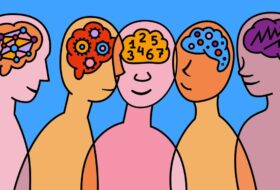
Researchers have uncovered evidence that the brains of people with gambling disorders exhibit physical differences from healthy brains, similar to the differences exhibited in those with substance use disorders (SUD). The researchers suggest that a part of the brain called the fronto-striatal-thalamic (FST) circuit may play a crucial role in addictions, including gambling disorders.
Finnish researchers from the University of Turku used magnetic resonance imaging (MRI) to examine the integrity of white matter connections in individuals with gambling disorders. Notably, the FST circuit is a neuronal pathway originating in the prefrontal cortex (PFC) that connects several frontal lobe regions to other parts of the brain, including the striatum and the thalamus.
The investigators hoped their results would confirm the role of the circuit in participants with gambling disorders. Upon completion, they found participants with gambling disorder had reduced white matter integrity in both frontal hemispheres and more lesions in the left hemisphere. The results also showed reduced gray matter volume and thickness in the left hemisphere.
In human brains, white matter enables communication between different regions. Gray matter receives those communications and processes things like perception, voluntary movement, speech, and understanding.
The study doesn’t explicitly say whether the brain differences are a precursor to gambling disorder or result from it. The researchers did not respond to Bonus’s request for clarification.
Still, the way addictions typically play out, it could be something of a feedback loop. Overindulgence in a particular source of dopamine (in this case, gambling) could cause damage to related brain structures, which, in turn, would hamper self-control. However, the authors indicate the need for more research to uncover the specific relationship.
Research Examines Brain’s Role in Gambling Disorders
According to accepted diagnostic criteria (DSM-5), gambling disorder is a nonsubstance-related addiction disorder that affects an estimated 1% to 3.5% of adults globally. The medical establishment characterizes gambling disorder as “an alteration in reward processing, compulsion, withdrawal, and a lack of executive control” and additional “clinical characteristics.”
Importantly, the researchers note that although gambling disorder is a worldwide problem thought to be on the rise, there are no specific drug or neuromodulation (nerve stimulation) treatments available.
As the researchers share in their introduction, changes in structural brain connections appear important in substance use disorders. However, their role in behavioral addictions, such as gambling disorders, remains unclear.
While small, with just 60 participants (20 with gambling disorder and 40 healthy controls), this research is an early attempt to understand if and how brain structures might play a role.
Each study participant underwent “detailed clinical examinations” alongside a series of magnetic resonance imaging (MRI) scans. Researchers then compared between groups and examined correlations with “gambling disorder-related behavioral characteristics.”
Structural Brain Differences Observed in Those with Gambling Disorders
Notably, researchers observed no group differences in age, sex proportion, or general cognitive capacity.
However, in addition to gambling-related variables, subjects struggling with gambling reported higher weekly alcohol and nicotine use. The same subjects also registered higher Beck Depression Inventory (BDI) scores, indicative of more severe depression symptoms than their non-disordered counterparts. Likewise, the prevalence of cardiovascular issues such as coronary heart disease, hypertension, and type 2 diabetes was higher than in the control group.
In terms of brain matter, subjects with gambling disorders had more visible damage to white matter in the left anterior corona radiata. The corona radiata is essentially a “neural highway” carrying traffic to and from the cerebral cortex, which handles things like language, memory, decision-making, and personality.
Importantly, the result remained when controlling for cardiovascular issues. However, researchers found no correlation between lesion load and gambling-related variables, such as hours or money spent gambling each week. Further, the results did not significantly associate with smoking, alcohol use, or depression scores.
Interventions Could Target FST Circuitry
As the study indicates, previous research has suggested multiple brain structures may play a part in gambling disorder, but the results have varied from study to study.
However, these latest findings show “converging evidence” implicating the FST circuitry, which previous research has associated with substance abuse disorders.
Our findings support gambling disorder as a condition associated with disruption of the fronto-striatal-thalamic circuit, highlighting the involvement of the left anterior corona radiata. Decreased integrity in the anterior corona radiata has also previously been associated with SUDs, such as alcohol or cocaine dependence.
Additionally, while results showed a primary impact on FST circuitry, researchers found additional regions in the brain showed differences in the surface-based analysis.
The authors also note that past research has rarely studied older adults with gambling disorders. That’s an unfortunate omission, as aging is also associated with an increase in white matter lesions. The researchers controlled for age and showed that disordered gamblers show greater white matter damage than control group members of similar age.
The authors hypothesize that the same circuitry in both substance and behavioral addictions may regulate and moderate addictive behaviors.
Based on the clear involvement of the fronto-striatal-thalamic regions across addictive behaviors, an intervention targeting this circuit (e.g. indirectly modulating the circuit by targeting the frontal cortex) may effectively rebalance the network.
However, researchers reiterate that a deeper understanding would require further study.





